In this article, you will learn about distance formula , midpoint , and equations of circle. The circle is a geometric shape that has a special significance in mathematics. To study the circle, in algebraic form, we need to define it in terms of coordinates in a 2d coordinate system also known as Cartesian coordinate system.
Coordinate System
You are familiar with the 2d coordinate system already from previous articles. The 2d coordinate system define an point in terms of an ordered pair ![]() from origin
from origin ![]() . The
. The ![]() represents horizontal distance from 0 and
represents horizontal distance from 0 and ![]() represents vertical distance from
represents vertical distance from ![]() .
.
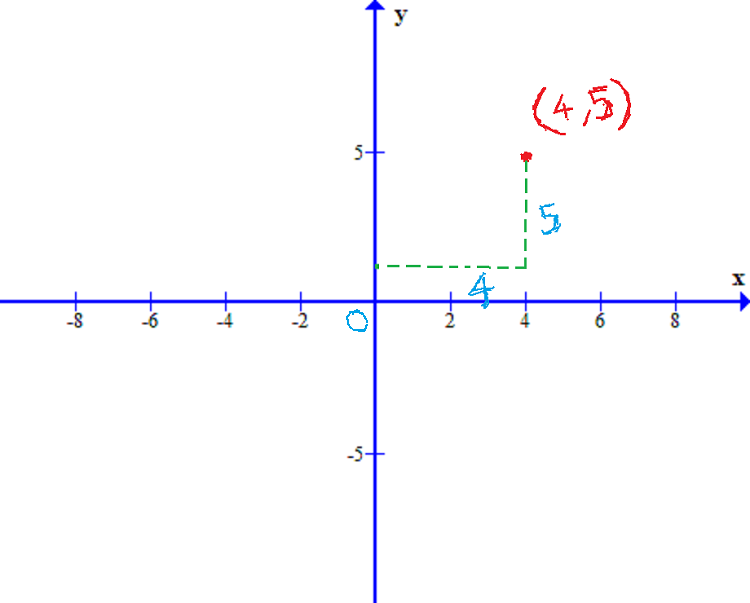
In the figure 1 above, the point ![]() is
is ![]() units in horizontal direction from
units in horizontal direction from ![]() and
and ![]() units in vertical direction from
units in vertical direction from ![]() . Therefore, we must study the circle as a set of points in this 2d coordinate system.
. Therefore, we must study the circle as a set of points in this 2d coordinate system.
Distance Formula
The distance formula is derived from Pythagorean theorem to find the distance between two points in the coordinate system. Suppose that ![]() and
and ![]() are two points in the
are two points in the ![]() plane.
plane.
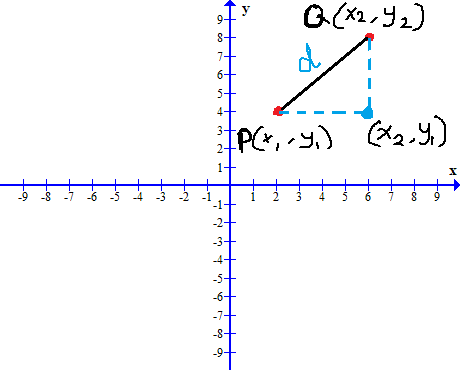
The distance between point ![]() to point
to point ![]() involve change of
involve change of ![]() value from
value from ![]() to
to ![]() value and change in
value and change in ![]() value from
value from ![]() to
to ![]() . This forms a right triangle in the
. This forms a right triangle in the ![]() plane.
plane.
The distance ![]() is hypotenuse of this right triangle and
is hypotenuse of this right triangle and ![]() and
and ![]() are the lengths of sides of this right triangle. Therefore, by Pythagorean theorem,
are the lengths of sides of this right triangle. Therefore, by Pythagorean theorem,
\begin{aligned}
&d^2 = (x_1 - x_2)^2 + (y_1 - y_2)^2\\ \\
&Take \hspace{2mm} square \hspace{2mm} root \hspace{2mm} of \hspace{2mm} both\hspace{2mm} sides. \\ \\
&\sqrt{d^2}= \sqrt{(x_1 - x_2)^2 + (y_1 - y_2)^2} \\ \\
&d =\sqrt{(x_1 - x_2)^2 + (y_1 - y_2)^2}
\end{aligned}
The distance formula is ![]() .
.
Note that the length ![]() or
or ![]() does not matter as long as we take
does not matter as long as we take ![]() or
or ![]() . Similarly, we must take positive
. Similarly, we must take positive ![]() value, which is
value, which is ![]() or
or ![]() .
.
Example #1
Find the distance between point ![]() and
and ![]() .
.
Solution:
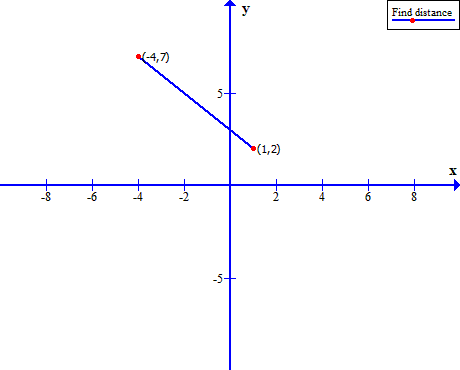
Solution:
\begin{aligned}
&Let \hspace{1mm} x_1 = -4 \hspace{1mm} and \hspace{1mm} y_1 = 7,\hspace{1mm}\\
&also \hspace{1mm}x_2 = 1 \hspace{1mm}and\hspace{1mm} y_2 = 2. \hspace{1mm}Then, \\
&(-4) - 1| = |-5| = 5 \hspace{1mm} and \hspace{1mm} |7-2| = |5| = 5
\end{aligned}
The distance between ![]() and
and ![]() is:
is:
\begin{aligned}
&d = \sqrt{5^2 + 5^2}\\ \\
&d = \sqrt{50}\\ \\
&d = \sqrt{25 \cdot 2}\\ \\
&d = \sqrt{25} \cdot \sqrt{2} \hspace{1cm} By Rule \sqrt{ab} = \sqrt{a} \cdot \sqrt{b}, {a,b} > 0\\ \\
&d = 5\sqrt{2}
\end{aligned}
Mid-Point Formula
Given any two point on the ![]() plane, you can find the mid-point
plane, you can find the mid-point ![]() . If
. If ![]() and
and ![]() are two points on the
are two points on the ![]() plane.
plane.
Then the mid-point formula is given as
\begin{aligned}
M(x, y) = \left( \frac{x_1 + x_2}{2},\frac{y_1 + y_2}{2}\right )
\end{aligned}
Example #2
Find the mid-point ![]() of points
of points ![]() and
and ![]() .
.
Solution:
We can easily find the mid-point ![]() using the mid-point formula, which is
using the mid-point formula, which is ![]() . Given points –
. Given points – ![]() and
and ![]() .
.
\begin{aligned}
&Let \hspace{2mm} x_1 = 2, \hspace{2mm} and \hspace{2mm} x_2 = 6\\ \\
&Similarly, \\ \\
&y_1 = 6,\hspace{2mm} and \hspace{2mm} y_2 = 10\\ \\
&Using \hspace{2mm} mid-point \hspace{2mm} formula, \hspace{2mm} get \\ \\
&M(x, y) = \frac{2 + 6}{2}, \frac{6 + 10}{2}\\ \\
&=\frac{8}{2},\frac{16}{2}\\ \\
&=(4,8)
\end{aligned}
Therefore, the mid-point ![]() .
.
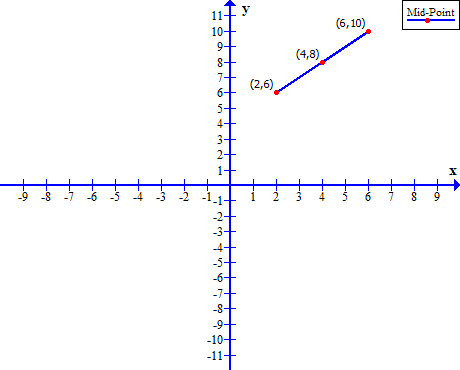
Standard Equation of Circle
A circle on the ![]() plane is set of all points that equidistant from a fixed point called the center of the circle. The equal distance between center and any point on the circle is called a radius.
plane is set of all points that equidistant from a fixed point called the center of the circle. The equal distance between center and any point on the circle is called a radius.
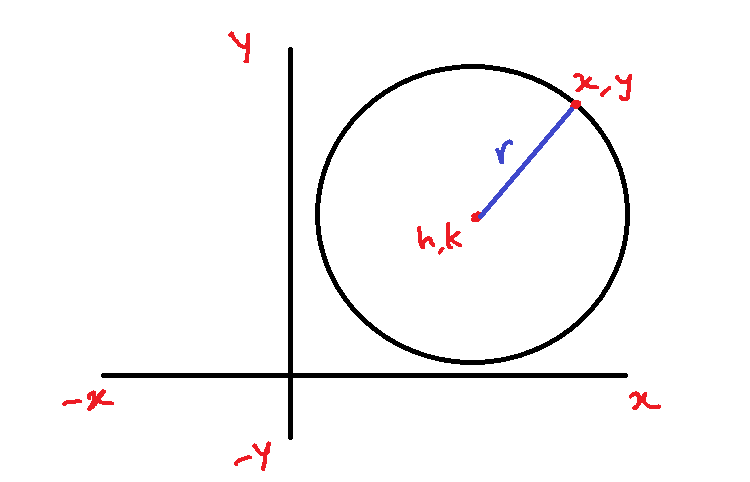
Consider the circle in figure 5, with radius ![]() and center at
and center at ![]() . The point
. The point ![]() lies on the circle. Therefore, by distance formula, we know that,
lies on the circle. Therefore, by distance formula, we know that,
\begin{aligned}
&r = \sqrt{(x-h)^2 + (y - k)^2}\\
\end{aligned}
This is the standard equation of a circle with center at ![]() .
.
Circle With Center At The Origin
In the co-ordinate system, the origin is point ![]() . A circle whose center is at
. A circle whose center is at ![]() has the following equation.
has the following equation.
\begin{aligned}
&r = \sqrt{(x - 0)^2 + (y - 0)^2}\\ \\
&r = \sqrt{x^2 + y^2}\\ \\
&or\\ \\
&r^2 = x^2 + y^2
\end{aligned}
Example #3
Find the radius of a circle whose center is at ![]() and the point
and the point ![]() lies on the circle.
lies on the circle.
Solution:
Given center ![]() and a point
and a point ![]() , we can use the standard equation of the circle to find the length of radius
, we can use the standard equation of the circle to find the length of radius ![]() .
.
\begin{aligned}
&r = \sqrt{(x-h)^2 + (y - k)^2}\\ \\
&r = \sqrt{(7-1)^2 + (10-2)^2} \\ \\
&r = \sqrt{6^2 + 8^2}\\ \\
&r = \sqrt{36 + 64}\\ \\
&r = \sqrt{100} \\ \\
&r = 10 \hspace{2mm}
\end{aligned}
Therefore, the length of radius is ![]() for circle whose center is at
for circle whose center is at ![]() and
and ![]() is a point on the circle.
is a point on the circle.
Example #4
Find the center ![]() of the circle whose radius
of the circle whose radius ![]() and the point
and the point ![]() . Also,
. Also, ![]() .
.
Solution:
We are given the value of radius ![]() and the point
and the point ![]() on the circle. To find the center point
on the circle. To find the center point ![]() of the circle, we must use the distance formula which is
of the circle, we must use the distance formula which is ![]() and the value of
and the value of ![]()
\begin{aligned}
&r = \sqrt{(x-h)^2 + (y-k)^2}\\ \\
&5= \sqrt{(6 - h)^2 + (8-k)^2}\\ \\
&But, \hspace{2mm} k = h + 1 \\ \\
&5= \sqrt{(6 - h)^2 + (8-(h+1))^2}\\ \\
&5 = \sqrt{(6 - h)^2+ (7 - h)^2)}\\ \\
&5 = \sqrt{36 - 12h + h^2 + 49 - 14h + h^2}\\ \\
&5 = \sqrt{85 - 26h + 2h^2 }\\ \\
&Square \hspace{2mm} both\hspace{2mm} sides \\ \\
&25 = 85 - 26h + 2h^2 \\ \\
&2h^2 - 26h + 85 - 25 = 0\\ \\
&2h^2 - 26h + 60 = 0\\ \\
&h^2 - 13h + 30 = 0 \\ \\
&(h - 3) (h - 10) = 0\\ \\
&By \hspace{2mm} zero\hspace{2mm} product \hspace{2mm} property\\ \\
&\therefore x = 3 \hspace{2mm} or \hspace{2mm} x = 10
\end{aligned}
We try to use the value of ![]() in the equation. It seems that
in the equation. It seems that ![]() seems more appropriate. Let us verify.
seems more appropriate. Let us verify.
\begin{aligned}
&5 = \sqrt{(6-3)^2+(8-4)^2}\\ \\
&5 = \sqrt{3^2 +4^2 } \hspace{1cm} \because k = h + 1 = 3 + 1 = 4\\ \\
&5 = \sqrt{9 + 16}\\ \\
&5 = \sqrt{25 }\\ \\
&\therefore 5 = 5
\end{aligned}
General Equation Of Circle
Suppose a circle has center at ![]() with a point on the circle
with a point on the circle ![]() . Therefore, we can find the standard equation of the circle using,
. Therefore, we can find the standard equation of the circle using,
\begin{aligned}
&r^2 = (x - h)^2 + (y - k)^2\\ \\
&r^2 = (x - 3)^2 + (y - 7)^2\\ \\
&r^2 = x^2 - 6x + 9 + y^2 - 14y + 49\\ \\
&r^2 = x^2 + y^2 - 6x - 14y + 58
\end{aligned}
Therefore, the general equation of circle is ![]() where
where ![]() are real constants.
are real constants.
Example #5
Given the general equation of circle ![]() find the coordinates for center
find the coordinates for center ![]() of the circle.
of the circle.
Solution:
Given general equation of circle. We will solve it step-by-step. First group the similar variables together and move constant to the right side of the equation.
\begin{aligned}x^2 - 6x + y^2 -14y = - 58\end{aligned}
Now solve for ![]() and
and ![]() by completing the square. Note that you have to add same value on both side of the equation.
by completing the square. Note that you have to add same value on both side of the equation.
[\begin{aligned}(x^2 - 6x + 9 ) + (y^2 - 14y + 49) = - 58 + 9 + 49\end{aligned}
The equation is in standard form and we can find the value of ![]() easily.
easily.
[\begin{aligned}(x - 3)^2 + (y - 7)^2 = 0^2\end{aligned}
The center of the circle is at ![]() .
.